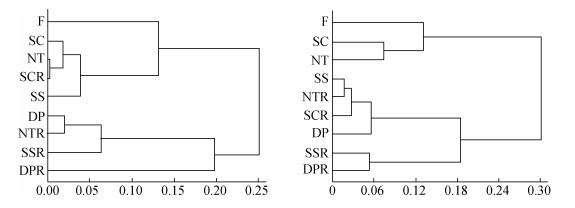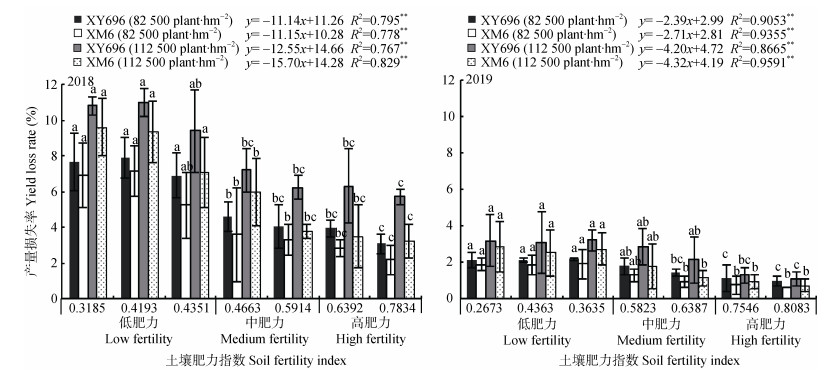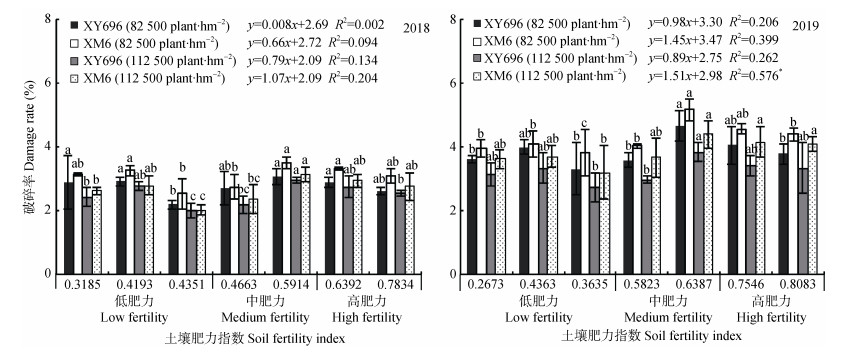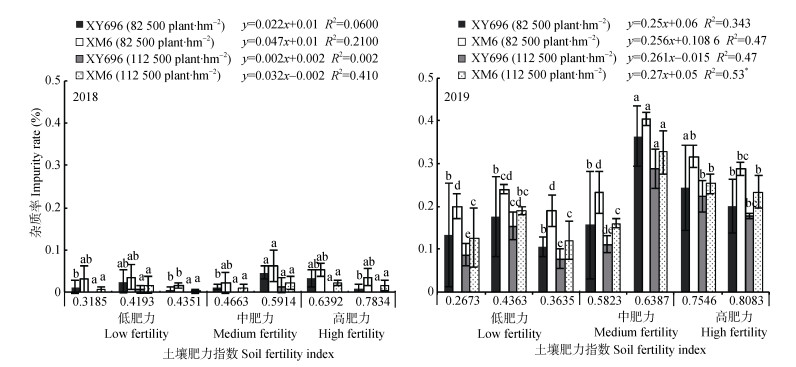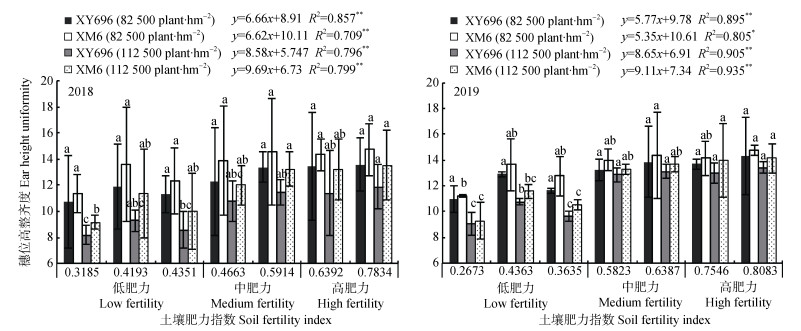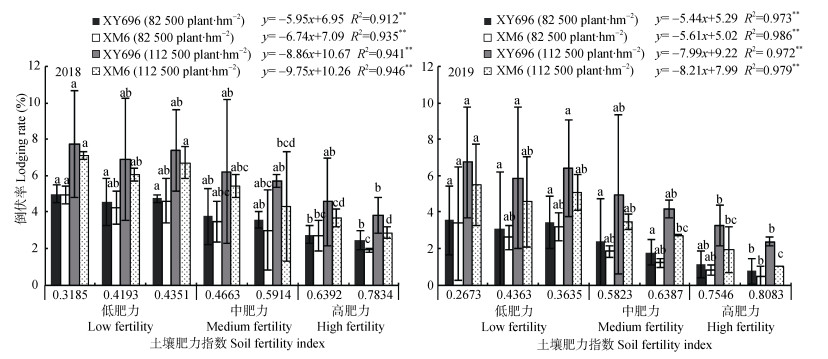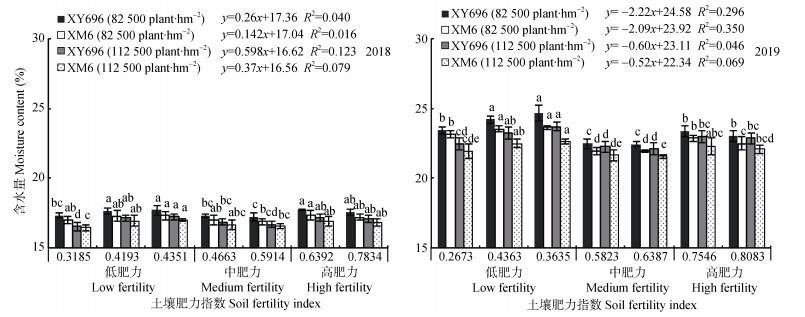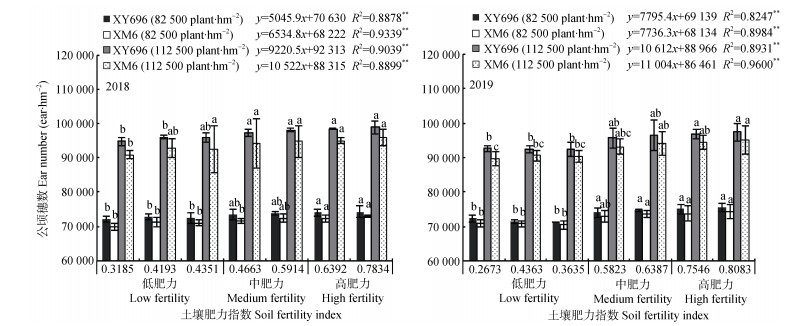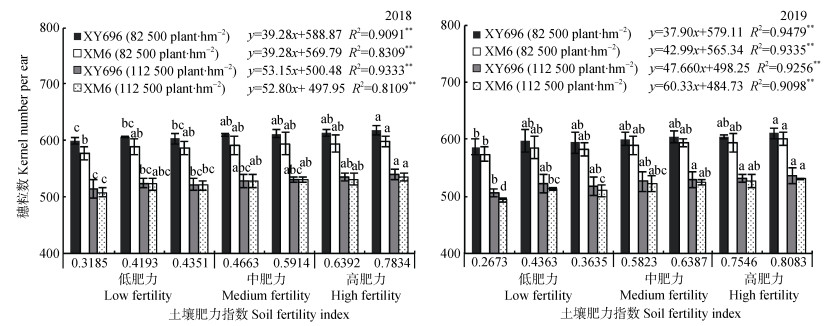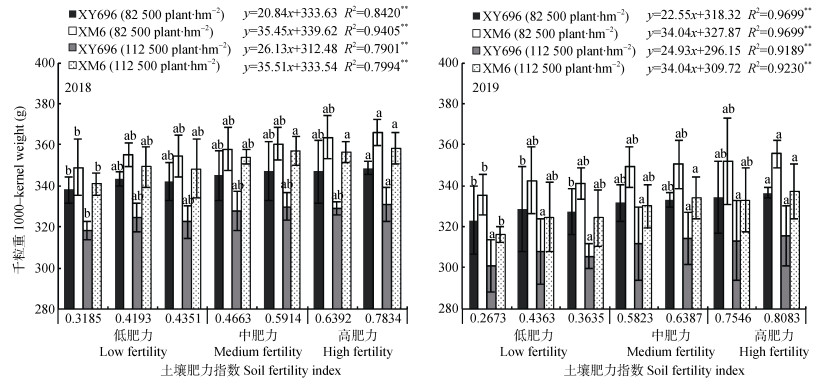Soil fertility improvement increases maize yield and reduces loss during mechanized grain harvest
-
摘要: 针对我国玉米生产中机械粒收存在产量损失率、破碎率高的问题,本试验以农户浅旋的土壤肥力为对照,设置深耕、免耕和秸秆原位还田措施等创造的不同土壤肥力水平,以‘先玉696’和‘西蒙6号’为试验材料,在高低两种种植密度下测定玉米机收质量、穗位整齐度、倒伏率、籽粒脱水速率和籽粒含水率,以及产量和产量构成等指标,揭示土壤肥力提升后对玉米机械粒收增产减损的影响机制。研究结果表明:1)提升土壤肥力可降低玉米机械粒收的产量损失率,在高密度下作用更加明显,每提升1个肥力单位,产量损失率下降12.55~15.70个百分点。2)提升土壤肥力可以使穗位整齐度提高5.35~9.69、玉米倒伏率降低5.44~9.75个百分点、籽粒平均脱水速率提高0.048~0.090%·d-1,有效缓解增密带来的负面影响,是产量损失率降低的主要原因。3)提高土壤肥力可明显增加玉米的有效穗数、穗粒数和千粒重,从而使玉米籽粒产量提高1878.5~2544.4 kg·hm-2;增密后高肥力水平土壤具有增产效果。因此,内蒙古地区通过耕作措施与秸秆还田提升土壤肥力可实现玉米机械粒收增产减损。Abstract: The rates of maize grain yield loss, grain crushing, and impurity during mechanized grain harvest in China are high. To reduce grain yield loss, the effects of soil fertility improvement on mechanized grain harvest quality were investigated to provide a theoretical basis for optimizing tillage and straw returning measures. Maize cultivars 'XY696' and 'XM6' were planted at high and low densities under different soil fertilities: low fertility (with tillage and straw returning measures of strip cultivation and no-tillage), medium fertility (with subsoiling and deep tillage), and high fertility (with straw incorporation, subsoiling, and straw incorporation with deep tillage). The farm rotary tillage (with much lower fertility) served as the control treatment. The following mechanized grain harvest quality indicators were measured: ear height uniformity, lodging rate, dehydration rate, and grain moisture content, as well as the yield and yield components. The results showed that soil fertility, maize cultivar, and planting density significantly (P < 0.05) affected the quality indexes of mechanized grain harvest, maize morphology characteristics, grain dehydration, and maize yield. Soil fertility improvement reduced grain yield loss during maize mechanized grain harvest, whereas the grain crushing and impurity rates did not change with soil fertility improvement. Under high planting density, yield loss decreased by 12.55-15.70 percentage for each fertility unit. Yield loss increased with increasing planting density, and the loss rate of 'XY696' was more than that of 'XM6'. Soil fertility improvement led to an increase in ear height uniformity (5.35-9.69), reduced maize lodging (5.44-9.75 percentage), and increased the grain dehydration rate (0.048-0.090%·d-1). Optimization of these indexes may explain the reduction in yield loss at high fertility. Increased planting density reduced ear height uniformity and increased the maize lodging and grain dehydration rates. Soil fertility improvement effectively alleviated the negative impacts of densification. 'XY696' had lower ear height uniformity, higher lodging, and slower dehydration compared to 'XM6', which led to higher grain loss for 'XY696'. Soil fertility improvement increased the ear numbers per unit area, grain numbers per ear, and 1000-grain weight, ultimately increasing yield by 1878.5-2544.4 kg·hm-2 for each fertility unit increase. The increase in maize grain yield was due to a reduction in grain yield loss during mechanized maize grain harvest. The number of ears per unit area increased, whereas the grain number per ear and the 1000-grain weight decreased when the planting density increased. Maize grain yield increased when the planting density increased at high fertility levels. Therefore, soil fertility improvement via tillage and straw returning can increase maize yield and reduce yield loss during mechanized grain harvest in Inner Mongolia. Under high soil fertility, a reasonable planting density increase can improve the yield and harvest quality and decrease the grain moisture content. Reduced mechanized grain loss can be achieved by selecting maize cultivars with high lodging resistance, high ear height uniformity, and a fast dehydration rate.
-
Keywords:
- Maize /
- Mechanized grain harvest /
- Soil fertility /
- Tillage measures /
- Straw returning /
- Yield loss
-
玉米(Zea mays)是我国第一大粮食作物, 2019年种植面积已超过0.4亿hm2, 在保障国家粮食安全中起到极其重要的作用。但是, 目前我国玉米收获主要以机械化穗收为主, 粒收面积很少。柴宗文等[1]对我国15个省(市)168个地块获得的1698组玉米收获质量样本数据分析表明, 破碎率高是当前中国玉米机械粒收存在的主要质量问题。李少昆等[2]2013—2017年对内蒙古玉米主产区的机械化籽粒直收研究结果表明, 收获时籽粒破碎率均值为9.89%, 产量总损失率均值为5.77%, 亦高于国家标准(≤5.0%)。可见, 限制我国玉米机械化籽粒直收的主要原因之一是机械粒收质量偏低, 收获损失大。在机械化粒收成为降低玉米生产成本, 提高我国玉米收获质量的有效途径和必然趋势的背景下, 如何提高机械化粒收质量成为我国玉米全程机械化发展的核心问题[3]。
收获时玉米的倒伏率、籽粒含水量是影响机械粒收质量的关键因素, 而倒伏率、籽粒含水量受品种、种植密度、水肥管理等多因素影响[3]。土壤作为玉米生长的载体, 耕地土壤肥力的高低影响其生长发育进程以及产量。前人开展的相关理论及技术研究证实, 合理的耕作和秸秆还田措施可有效提升土壤肥力[4-6]。然而, 土壤肥力提升后是否通过改善玉米生长发育特性达到机械粒收减损, 相关研究结果还少见报道。为了适应玉米生产方式转变, 满足籽粒直收需求, 本研究选用不同玉米品种, 设置高、低两种种植密度, 以耕作和秸秆还田措施为手段创造不同土壤肥力条件, 研究土壤肥力对玉米机械粒收质量、穗位整齐度、倒伏率、脱水速率及籽粒含水量等宜机械粒收特性的影响, 揭示土壤肥力提升对玉米机械粒收增产减损的机制, 为内蒙古地区采取适宜的耕作和秸秆还田方式提升土壤肥力, 实现玉米增收、机械化籽粒直收减损提供依据。
1. 材料与方法
1.1 试验地概况
试验于2018—2019年在内蒙古农业大学科技园区(内蒙古包头市土默特右旗沟门镇北只图村, 40°28′28″E, 110°29′5″N)进行。前茬作物为玉米。2018年玉米生长季日平均气温20.1 ℃, 降雨量486.6 mm; 2019年玉米生长季日平均气温20.6 ℃, 降雨量363.1 mm。播种前耕层土壤(0~30 cm土层)养分数据如表 1所示。
表 1 2018年和2019年不同耕作措施和秸秆还田的土壤养分情况Table 1. Soil nutrients contents of different tillage and straw returning measures in 2018 and 2019指标
Index年度Year 农户浅旋
Farmer rotary tillage (F)条深旋
Strip cultivation (SC)深松Subsoiling (SS) 深翻Deep tillage (DP) 免耕No-till (NT) 推茬清垄条
深旋
Straw incorporation with strip cultivation (SCR)深松秸秆
混拌还田
Straw incorporation with subsoiling (SSR)深翻秸秆
粉碎还田
Straw incorporation with deep tillage (DPR)秸秆覆盖
还田免耕播种Straw incorporation with no-tillage (NTR)碱解氮
Alkali-hydrolysable N (mg∙kg–1)2018 51.6 50.9 53.0 59.2 36.2 50.8 57.7 63.1 48.5 2019 52.4 51.6 51.0 62.9 46.5 65.9 77.1 58.2 67.9 速效磷
Available P
(mg∙kg–1)2018 2.2 3.1 3.4 4.3 4.9 3.4 3.6 5.6 5.1 2019 2.6 3.6 3.0 2.7 4.5 4.0 3.1 3.7 3.3 速效钾
Available K
(mg∙kg–1)2018 63.1 71.6 77.3 90.0 61.0 81.5 93.3 95.2 71.8 2019 60.6 73.8 83.9 90.2 69.5 85.5 92.7 113.7 77.8 有机质
Organic matter
(g∙kg–1)2018 19.7 21.2 24.4 23.8 19.7 25.6 25.3 26.4 28.9 2019 15.8 18.9 21.8 25.3 20.9 23.3 25.3 32.0 16.5 1.2 试验设计
试验采用再裂区试验设计, 主区为土壤肥力, 分别以农户浅旋(F)的土壤肥力为对照, 设置条深旋(SC)、深松(SS)、深翻(DP)、免耕(NT)、推茬清垄条深旋(SCR)、深松秸秆混拌还田(SSR)、深翻秸秆粉碎还田(DPR)、秸秆覆盖还田免耕播种(NTR)等8个处理下的土壤肥力, 2年肥力指数的具体数值见表 1。农户浅旋: 在秋季机械收获后秸秆离田, 春浅旋(15 cm), 整地播种; 条深旋: 秋季机械收获后秸秆离田, 春季条深旋(30 cm), 整地播种; 深松: 秋季机械收获后秸秆离田, 秋深松(35 cm以上), 春浅旋, 整地播种; 深翻: 秋季机械收获后秸秆离田, 秋深翻(35 cm以上), 春整地播种; 免耕: 秋季机械收获秸秆离田, 春免耕机播种; 推茬清垄条深旋: 秋季机械收获后秸秆全量粉碎覆盖还田, 春条旋耕30 cm, 推茬清垄播种机播种, 小双行; 深松秸秆混拌还田: 秋季机械收获后秸秆全量粉碎覆盖还田, 秋深松(35 cm以上), 春浅旋混拌使秸秆进入土中, 整地播种; 深翻秸秆粉碎还田: 秋季机械收获后秸秆全量二次粉碎, 秋深翻(35 cm以上)使秸秆翻入土中, 春整地播种; 秸秆覆盖还田免耕播种: 秋季机械收获后秸秆全量覆盖, 春粉碎还田、免耕播种。副区为品种, 分别为‘先玉696’(XY696)、‘西蒙6号’(XM6); 副副区为种植密度, 分别为8.25万株∙hm−2和11.25万株∙hm−2。每处理3次重复, 每一重复的小区面积390 m2, 长65 m, 宽6 m, 种植行距60 cm, 株距按密度调节。2年连续试验各处理田间排列和位置固定, 2018年4月23日播种, 10月28日机械收获籽粒; 2019年4月26日播种, 10月26机械收获籽粒。肥料管理如下: 施纯N 465.0 kg∙hm−2、P2O5 210.0 kg∙hm−2、K2O 202.5 kg∙hm−2, 其中, N按3∶7分别于拔节、大口期追施, P2O5和K2O作为基肥一次性施入。其他管理同大田生产。不同耕作方式下土壤肥力指数见表 2。
表 2 2018年和2019年不同耕作措施和秸秆还田的土壤肥力指数Table 2. Soil fertility indexes of different tillage and straw returning measures in 2018 and 2019年份
Year农户浅旋Farmer rotary tillage (F) 条深旋Strip cultivation (SC) 深松Subsoiling (SS) 深翻
Deep tillage (DP)免耕No-till (NT) 推茬清垄条深旋
Straw incorporation with strip cultivation (SCR)深松秸秆混拌还田
Straw incorporation with subsoiling (SSR)深翻秸秆粉碎还田
Straw incorporation with deep tillage (DPR)秸秆覆盖还田
免耕播种
Straw incorporation with no-tillage (NTR)2018 0.3185 0.4193 0.4663 0.5914 0.4351 0.4368 0.6392 0.7834 0.5730 2019 0.2673 0.4364 0.5823 0.6387 0.3625 0.6006 0.7546 0.8083 0.5650 土壤肥力评价指标分别为土壤容重、紧实度、孔隙度、含水量、氮磷钾、有机质、过氧化氢酶、脲酶、蔗糖酶、细菌、放线菌、真菌和阳离子交换量; 评价方法根据国家耕地质量等级GB/T 33469—2016。The soil fertility indexes were calculated with soil bulk density, compactness, porosity, water content, nitrogen, phosphorus, potassium, organic matter, catalase, urease, sucrase, bacteria, actinomycetes, fungi and cation exchange according to the National Cultivated Land Quality Grade GB/T 33469—2016. 1.3 测定指标与方法
1) 穗位变异系数: 于乳熟期每一重复选取15株有代表性的连续植株, 测定穗位高, 计算穗位变异系数。
$$ 穗位整齐度=1/穗位变异系数 $$ (1) 2) 倒伏率: 于收获前一天调查倒伏, 倒伏是指茎秆倾斜角度小于45°和茎折的植株, 计算倒伏率。
$$ 倒伏率( {\rm{\% }} )=调查倒伏数/调查总株数 \times 100 {\rm{\% }} $$ (2) 3) 收获籽粒含水量(%): 在机收后的籽粒中, 用谷物水分测定仪PM-8188(日本KETT公司), 测定收获籽粒含水率, 每处理测5次重复计算平均值。
4) 籽粒脱水特性: 于吐丝后32 d开始取样, 每6 d取一次, 至收获共取样11次, 每一重复取整齐一致的5个果穗, 手工脱粒, 测定鲜重、干重, 计算籽粒含水率和籽粒平均脱水速率。
$$ 籽粒含水率( {\rm{\% }} )=(籽粒鲜重−籽粒干重) \div 籽粒鲜 \\ 重 \times 100% $$ (3) $$ 籽粒平均脱水速率( {\rm{\% }} )=(第1次取样含水率−最 \\ 后取样含水率)/两次取样间隔天数 \times 100 {\rm{\% }} $$ (4) 5) 人工测产及考种: 在收获期测产, 去除边行效应, 每一处理随机选取3点, 每点验收2行, 量取5 m, 准确量取测产区面积, 并调查该面积内总株数、穗数、双穗数、空秆数、倒伏数、实际收获株数、收获总穗数。随后将每处理所取果穗自然风干, 留作室内考种。测定项目包括: 穗粒重、粒重、千粒重、行粒数、穗行数和产量等。
6) 机收测产及产量损失率调查: 每一处理选取无破坏性取样的重复进行机械粒收测产, 所用收获机械为约翰迪尔R230玉米籽粒收获机, 测产方法按照DB15/T 1468—2018地方标准。两边地头各去除2.5 m行长, 测产长度为60 m, 宽度为3.6 m。每处理随机选取5个样点, 每样点为2 m行长, 一个割幅宽(6行区玉米), 收集样点内落粒、落穗, 称籽粒重, 计算产量损失率。
7) 籽粒破碎率和杂质率: 随机取机械收获后的玉米籽粒约2 kg, 3次重复, 将其重量计为W, 然后将其分为籽粒和杂质两部分。对籽粒称重(WK), 杂质称重(WN), 从籽粒中挑出破碎籽粒, 并称重(WK1), 计算籽粒破碎率和杂质率。
$$ \text { 栋粒破碎率 }(\%)=\left(W_{\mathrm{K} 1} / W_{\mathrm{K}}\right) \times 100 \% $$ (5) $$ \text { 杂质率 }(\%)=\left(W_{\mathrm{N}} / W\right) \times 100 \% $$ (6) 1.4 数据统计分析
采用Microsoft Excel 2010记录与整理数据、作图, 统计分析软件SPSS 20.0进行聚类分析和方差分析。对于服从二项分布的数据, 作方差分析前对数据进行转换, 使其符合正态分布。以机收质量、产量及其构成因素等指标为依变量, 肥力指数为自变量进行回归分析, 明确随着土壤肥力提高, 各指标的变化规律; 对同一品种、同一密度下不同肥力之间的指标进行多重比较(LSD法), 明确肥力间的差异性。
2. 结果与分析
2.1 不同耕作方式土壤肥力聚类
由2018—2019年不同耕作方式土壤肥力指数(表 2)聚类分析可知, 2018年在阈值0.1209处将9个处理的肥力分为3类, 高肥力为DPR, 中肥力为DP、NTR和SSR, 低肥力为F、SC、NT、SCR和SS; 2019年连续作业后, 在阈值0.1321处将9个处理的肥力分为3类, DPR、SSR为高肥力, DP、SCR、NTR、SS为中肥力, F、SC、NT为低肥力(图 1)。两年不同耕作方式的土壤肥力分类基本一致。以下分析均选取每个肥力水平下的两种典型耕作方式为代表, 其中低肥力水平选择SC和NT, 中肥力选择SS和DP, 高肥力选择SSR和DPR, 处理F为对照。F肥力水平为0.3185(2018年)、0.2673(2019年)。
![]() 图 1 2018年和2019年各耕作方式下土壤肥力聚类结果F、SC、NT、SS、DP、SCR、NTR、SSR和DPR分别表示农户浅旋、条深旋、免耕、深松、深翻、推茬清垄条深旋、秸秆覆盖还田免耕播种、深松秸秆混拌还田和深翻秸秆粉碎还田。F, SC, NT, SS, DP, SCR, NTR, SSR, and DPR mean farmer rotary tillage, strip cultivation, no-till, subsoiling, deep tillage, straw incorporation with strip cultivation, straw incorporation with no-tillage, straw incorporation with subsoiling, straw incorporation with deep tillage, respectively.Figure 1. Clustering results of soil fertility under various tillage and straw returning measures in 2018 and 2019
图 1 2018年和2019年各耕作方式下土壤肥力聚类结果F、SC、NT、SS、DP、SCR、NTR、SSR和DPR分别表示农户浅旋、条深旋、免耕、深松、深翻、推茬清垄条深旋、秸秆覆盖还田免耕播种、深松秸秆混拌还田和深翻秸秆粉碎还田。F, SC, NT, SS, DP, SCR, NTR, SSR, and DPR mean farmer rotary tillage, strip cultivation, no-till, subsoiling, deep tillage, straw incorporation with strip cultivation, straw incorporation with no-tillage, straw incorporation with subsoiling, straw incorporation with deep tillage, respectively.Figure 1. Clustering results of soil fertility under various tillage and straw returning measures in 2018 and 20192.2 土壤肥力对玉米机械粒收质量的影响
从表 3分析可知, 玉米产量损失率两年均在土壤肥力、密度间存在显著差异(P < 0.05), 籽粒破碎率两年均在土壤肥力、品种、密度和土壤肥力×密度间存在极显著或显著差异(P < 0.01或P < 0.05), 杂质率两年均在土壤肥力、种植品种、密度间存在极显著差异(P < 0.01)。土壤肥力、品种、密度对玉米机械粒收质量均有显著影响, 但除破碎率在土壤肥力×密度间存在显著互作效应外, 其他因素不存在显著的互作效应。土壤肥力、种植密度及其二者互作对玉米倒伏率也有明显影响(P < 0.05)。因此, 土壤肥力对玉米机械籽粒直收质量的影响可进一步分析。
表 3 2018—2019年不同处理下玉米机械粒收质量和倒伏率的方差分析Table 3. Analysis of variance on maize mechanized grain harvest quality in different tillage and straw returning measures in 2018 and 2019变异来源
Source of variation2018 2019 损失率
Loss
rate破碎率
Crushing
rate杂质率Impurity rate 倒伏率
Lodging
rate损失率
Loss rate破碎率Crushing rate 杂质率Impurity rate 倒伏率
Lodging
rate土壤肥力Soil fertility * ** ** ** * ** ** * 品种Variety ns ** ** ns ns ** ** ns 密度Density * ** ** ** * ** ** ** 土壤肥力×品种Soil fertility × variety ns ns ns ns ns * ns ns 土壤肥力×密度Soil fertility × density ns * ns * ns * * * 品种×密度Variety × density ns * ns ns ns ns ns ns 土壤肥力×品种×密度
Soil fertility × variety × densityns ns ns ns n ns ns ns *、**分别表示P < 0.05和P < 0.01水平影响显著, ns表示影响不显著。*, ** indicate significant effects at P < 0.05 and P < 0.01 levels, respectively; “ns” indicates no significant effect. 2.2.1 对玉米产量损失率的影响
由图 2可知, 提高土壤肥力, 玉米机械化收获产量损失率降低。在低密度水平下, 肥力水平提高1个单位, 产量损失率下降11.14~11.15个百分点(2018年)和2.39~2.71个百分点(2019年); 高密度条件下, 肥力提高对产量减损作用更加明显, 肥力增加1个单位, 产量损失率下降12.55~15.70个百分点(2018)和4.20~4.32个百分点(2019)。
![]() 图 2 2018年和2019年土壤肥力对玉米品种‘先玉696’(XY696)和‘西蒙6号’(XM6)在高密度(112 500株∙hm−2)和低密度(82 500株∙hm−2)下产量损失率的影响同一品种同一密度下, 不同小写字母表示不同肥力间在P < 0.05水平差异显著。**表示P < 0.01水平肥力水平和产量损失率回归公式显著。Different lowercase letters mean significant differences among different soil fertilities for the same maize variety under the same planting density. ** means significant regression equation between soil fertility and yield loss rate at P < 0.01 level.Figure 2. Effects of soil fertility on maize grain yield loss rates of maize varieties 'XY696' and 'XM6' at high (112 500 plants∙hm−2) and low (82 500 plants∙hm−2) densities in 2018 and 2019
图 2 2018年和2019年土壤肥力对玉米品种‘先玉696’(XY696)和‘西蒙6号’(XM6)在高密度(112 500株∙hm−2)和低密度(82 500株∙hm−2)下产量损失率的影响同一品种同一密度下, 不同小写字母表示不同肥力间在P < 0.05水平差异显著。**表示P < 0.01水平肥力水平和产量损失率回归公式显著。Different lowercase letters mean significant differences among different soil fertilities for the same maize variety under the same planting density. ** means significant regression equation between soil fertility and yield loss rate at P < 0.01 level.Figure 2. Effects of soil fertility on maize grain yield loss rates of maize varieties 'XY696' and 'XM6' at high (112 500 plants∙hm−2) and low (82 500 plants∙hm−2) densities in 2018 and 2019种植密度增加, 产量损失率增加。增加密度后, ‘XY696’和‘XM6’两年的平均产量损失率分别增加1.70和1.06个百分点。以2018年为例, ‘XY696’和‘XM6’高密度种植条件平均产量损失率为8.11%、6.09%, 而低密度条件分别为5.45%和4.47%。‘XY696’产量损失率略高于‘XM6’。
综上所述说明, 与F肥力相比, 采取耕作及秸秆还田措施提升土壤肥力后可明显降低产量损失率, 随种植密度增加, 降低幅度增大。
2.2.2 对籽粒破碎率的影响
如图 3所示, 不同土壤肥力间玉米籽粒破碎率存在差异, 低肥力水平的籽粒破碎率略低于农户浅旋(F); 中、高肥力水平的籽粒破碎率略高于F。具体而言, 2018年F肥力籽粒破碎率为2.75%, 低、中、高肥力分别为2.54%、2.82%和2.85%。2018年和2019年回归方程显示, 随着肥力的提高, 籽粒的破碎率无明显增减趋势。
![]() 图 3 2018年和2019年土壤肥力对玉米品种‘先玉696’(XY696)和‘西蒙6号’(XM6)在高密度(112 500株∙hm−2)和低密度(82 500株∙hm−2)下籽粒破碎率的影响同一品种同一密度下, 不同小写字母表示不同肥力水平间在 P<0.05 水平差异显著。*表示 P<0.05 水平肥力水平和籽粒破碎率回归公式显 著。Different lowercase letters mean significant differences among different soil fertilities for the same maize variety under the same planting density. * means significant regression equation between soil fertility and grain damage rate at P<0.05 level.Figure 3. Effects of soil fertility on maize grain damage rates of maize varieties 'XY696' and 'XM6' at high (112 500 plants∙hm−2) and low (82 500 plants∙hm−2) densities in 2018 and 2019
图 3 2018年和2019年土壤肥力对玉米品种‘先玉696’(XY696)和‘西蒙6号’(XM6)在高密度(112 500株∙hm−2)和低密度(82 500株∙hm−2)下籽粒破碎率的影响同一品种同一密度下, 不同小写字母表示不同肥力水平间在 P<0.05 水平差异显著。*表示 P<0.05 水平肥力水平和籽粒破碎率回归公式显 著。Different lowercase letters mean significant differences among different soil fertilities for the same maize variety under the same planting density. * means significant regression equation between soil fertility and grain damage rate at P<0.05 level.Figure 3. Effects of soil fertility on maize grain damage rates of maize varieties 'XY696' and 'XM6' at high (112 500 plants∙hm−2) and low (82 500 plants∙hm−2) densities in 2018 and 2019种植密度增加, 籽粒破碎率降低, ‘XY696’ ‘XM6’籽粒破碎率两年平均降低0.42~0.44个百分点。以2018年为例, ‘XY696’和‘XM6’高密度种植条件平均籽粒破碎率为2.51%和2.65%, 而低密度条件分别为2.74%和3.06%。就品种而言, ‘XY696’的平均籽粒破碎率为3.08%, ‘XM6’为3.65%。
上述分析表明, 土壤肥力提升对籽粒破碎率影响不明显, 增加密度后有降低籽粒破碎率的趋势。
2.2.3 对玉米杂质率的影响
本试验中玉米机械化籽粒直收的杂质主要是破碎的玉米芯。从图 4可见, 随着土壤肥力水平增加, 收获籽粒的杂质率无明显增减趋势。低肥力水平的杂质率与农户浅旋(F)差异不大; 中、高肥力水平的杂质率略高于F。具体而言, 2019年F肥力杂质率为0.14%, 低、中、高肥力分别为0.15%、0.26%和0.24%。
![]() 图 4 2018年和2019年土壤肥力对玉米品种‘先玉696’(XY696)和‘西蒙6号’(XM6)在高密度(112 500株∙hm−2)和低密度(82 500株∙hm−2)下杂质率的影响同一品种同一密度下, 不同字母表示不同肥力水平间在P < 0.05水平差异显著。*表示P < 0.05水平肥力水平和杂质率回归公式显著。Different lowercase letters mean significant differences among different soil fertilities for the same maize variety under the same planting density. * means significant regression equation between soil fertility and impurity rate at P < 0.05 level.Figure 4. Effects of soil fertility on maize impurity rates of maize varieties 'XY696' and 'XM6' at high (112 500 plants∙hm−2) and low (82 500 plants∙hm−2) densities in 2018 and 2019
图 4 2018年和2019年土壤肥力对玉米品种‘先玉696’(XY696)和‘西蒙6号’(XM6)在高密度(112 500株∙hm−2)和低密度(82 500株∙hm−2)下杂质率的影响同一品种同一密度下, 不同字母表示不同肥力水平间在P < 0.05水平差异显著。*表示P < 0.05水平肥力水平和杂质率回归公式显著。Different lowercase letters mean significant differences among different soil fertilities for the same maize variety under the same planting density. * means significant regression equation between soil fertility and impurity rate at P < 0.05 level.Figure 4. Effects of soil fertility on maize impurity rates of maize varieties 'XY696' and 'XM6' at high (112 500 plants∙hm−2) and low (82 500 plants∙hm−2) densities in 2018 and 2019两玉米品种均表现为种植密度增加杂质率降低, ‘XY696’ ‘XM6’增加密度后杂质率平均降低0.03和0.04个百分点。以2019年为例, ‘XY696’和‘XM6’高密度种植条件平均杂质率为0.16%和0.20%, 而低密度条件分别为0.20%和0.27%。‘XY696’的平均杂质率0.095%, 低于‘XM6’的0.13%。
2.3 土壤肥力对玉米形态学性状的影响
2.3.1 对玉米穗位整齐度的影响
由图 5可知, 不同肥力水平下玉米穗位整齐度存在明显差异, 随着土壤肥力的提升, 穗位整齐度明显提高。综合2018年和2019年的结果, 低密度条件下, 土壤肥力增加1个单位, 穗位整齐度以5.35~6.66的速率提高; 高密度条件下, 土壤肥力增加对整齐度的提高作用更加明显, 速率为8.58~9.69。
![]() 图 5 2018年和2019年土壤肥力对玉米品种‘先玉696’(XY696)和‘西蒙6号’(XM6)在高密度(112 500株∙hm−2)和低密度(82 500株∙hm−2)下穗位高整齐度影响同一品种同一密度下, 不同字母表示不同肥力水平间在P < 0.05水平差异显著。**和*分别表示P < 0.01和P < 0.05水平肥力水平和穗位高整齐度回归公式显著。Different lowercase letters mean significant differences among different soil fertilities for the same maize variety under the same planting density. * and ** mean significant regression equations between soil fertility and uniformity of ear height of maize varieties at P < 0.01 and P < 0.05 levels, respectively.Figure 5. Effects of soil fertility on uniformities of ear height of maize varieties 'XY696' and 'XM6' at high (112 500 plants∙hm−2) and low (82 500 plants∙hm−2) densities in 2018 and 2019
图 5 2018年和2019年土壤肥力对玉米品种‘先玉696’(XY696)和‘西蒙6号’(XM6)在高密度(112 500株∙hm−2)和低密度(82 500株∙hm−2)下穗位高整齐度影响同一品种同一密度下, 不同字母表示不同肥力水平间在P < 0.05水平差异显著。**和*分别表示P < 0.01和P < 0.05水平肥力水平和穗位高整齐度回归公式显著。Different lowercase letters mean significant differences among different soil fertilities for the same maize variety under the same planting density. * and ** mean significant regression equations between soil fertility and uniformity of ear height of maize varieties at P < 0.01 and P < 0.05 levels, respectively.Figure 5. Effects of soil fertility on uniformities of ear height of maize varieties 'XY696' and 'XM6' at high (112 500 plants∙hm−2) and low (82 500 plants∙hm−2) densities in 2018 and 2019增加种植密度后, 玉米的穗位整齐度下降, ‘XY696’和‘XM6’两年平均下降1.68、1.45。以2018年为例, ‘XY696’和‘XM6’高密度种植条件平均整齐度为10.57和12.22, 而低密度条件分别为12.66和13.92。高肥力下增加种植密度, 穗位整齐度的降幅低于低肥力下的增密结果, ‘XY696’在对照农户浅旋(F)肥力条件增密, 整齐度下降2.56, 在高肥力(DPR)条件增密, 整齐度下降1.72。
从以上分析可见, 提升土壤肥力可以提高穗位的整齐度, 且土壤肥力水平高可缓解增加密度压力带来的穗位整齐度下降幅度。
2.3.2 对玉米倒伏率的影响
随着土壤肥力的提升, 玉米倒伏率明显降低。综合2018年和2019年的结果, 低密度条件下, 土壤肥力增加1个单位, 倒伏率下降5.44~6.74个百分点; 高密度条件下, 土壤肥力增加对降低倒伏率的作用更加明显, 倒伏率下降7.99~9.75个百分点(图 6)。
![]() 图 6 2018年和2019年土壤肥力对玉米品种‘先玉696’(XY696)和‘西蒙6号’(XM6)在高密度(112 500株∙hm−2)和低密度(82 500株∙hm−2)下玉米倒伏率的影响同一品种同一密度下, 不同字母表示不同肥力水平间在P < 0.05水平差异显著。**表示P < 0.01水平肥力水平和玉米倒伏率回归公式显著。Different lowercase letters mean significant differences among different soil fertilities for the same maize variety under the same planting density. ** means significant regression equation between soil fertility and maize lodging rate at P < 0.01 level.Figure 6. Effects of soil fertility on maize lodging rates of maize varieties 'XY696' and 'XM6' at high (112 500 plants∙hm−2) and low (82 500 plants∙hm−2) densities in 2018 and 2019
图 6 2018年和2019年土壤肥力对玉米品种‘先玉696’(XY696)和‘西蒙6号’(XM6)在高密度(112 500株∙hm−2)和低密度(82 500株∙hm−2)下玉米倒伏率的影响同一品种同一密度下, 不同字母表示不同肥力水平间在P < 0.05水平差异显著。**表示P < 0.01水平肥力水平和玉米倒伏率回归公式显著。Different lowercase letters mean significant differences among different soil fertilities for the same maize variety under the same planting density. ** means significant regression equation between soil fertility and maize lodging rate at P < 0.01 level.Figure 6. Effects of soil fertility on maize lodging rates of maize varieties 'XY696' and 'XM6' at high (112 500 plants∙hm−2) and low (82 500 plants∙hm−2) densities in 2018 and 2019玉米种植密度加大, 倒伏率增加, ‘XY696’和‘XM6’两年平均增加2.36和1.57个百分点。以2018年为例, ‘XY696’和‘XM6’高密度种植条件平均倒伏率为6.05%和5.17%, 而低密度条件分别为3.84%和3.57%。高肥力下增加种植密度, 玉米倒伏率的增幅低于低肥力下的增密结果, 以‘XY696’为例, 对照F肥力条件下增加种植密度, 倒伏率增加2.70个百分点, 在高肥力(DPR)条件下增加种植密度, 倒伏率增加1.37个百分点。
综上所述, 土壤肥力提升可降低玉米的倒伏率, 且高密度条件下作用效果更加明显。
2.4 土壤肥力对玉米收获籽粒含水率及籽粒脱水特性的影响
从表 4可知, 籽粒平均脱水速率、收获籽粒含水率两年均在土壤肥力、种植密度和品种间存在极显著差异(P < 0.01), 玉米种植密度与品种交互对籽粒脱水速率有明显影响。
表 4 2018年和2019年不同处理间玉米收获籽粒含水率的方差分析Table 4. Analysis of variance on maize grain moisture content in harvested between different tillage and straw returning measures in 2018 and 2019变异来源
Source of variation籽粒脱水速率
Grain dehydration rate收获籽粒含水率
Harvested grain moisture content2018 2019 2018 2019 土壤肥力Soil fertility ** ** ** ** 品种Variety ** ** ** ** 密度Density ** ** ** ** 土壤肥力×品种Soil fertility × variety ns ns ns ns 土壤肥力×密度Soil fertility × density ns ns ns ** 品种×密度Variety × density * ** * ns 土壤肥力×品种×密度Soil fertility × variety × density ns ns ns ns *、**分别表示P < 0.05和P < 0.01水平影响显著, ns表示影响不显著。*, ** indicate significant effects at P < 0.05 and P < 0.01 levels, respectively; “ns” indicates no significant effect. 2.4.1 对籽粒脱水特性的影响
由图 7可知, 随着土壤肥力提高, 玉米籽粒的平均脱水速率明显增加。‘XY696’低密度种植, 高肥力水平对脱水速率没有明显提高效果, 在高密度条件下, 每增加1个肥力单位, 脱水速率提高0.048~ 0.079 %∙d–1。‘XM6’在高、低密度条件下随着肥力提高, 脱水速率均呈线性增加(0.048~0.09 %∙d–1)。
![]() 图 7 2018年和2019年土壤肥力对玉米品种‘先玉696’(XY696)和‘西蒙6号’(XM6)在高密度(112 500株∙hm−2)和低密度(82 500株∙hm−2)下籽粒平均脱水速率的影响同一品种同一密度下, 不同字母表示不同肥力水平间在P < 0.05水平差异显著。**和*分别表示P < 0.01和P < 0.05水平肥力水平和脱水速率回归公式显著。Different lowercase letters mean significant differences among different soil fertilities for the same maize variety under the same planting density. * and ** mean significant regression equations between soil fertility and grain dehydration rate at P < 0.01 and P < 0.05 levels, respectively.Figure 7. Effects of soil fertility on grain dehydration rates of maize varieties 'XY696' and 'XM6' at high (112 500 plants∙hm−2) and low (82 500 plants∙hm−2) densities in 2018 and 2019
图 7 2018年和2019年土壤肥力对玉米品种‘先玉696’(XY696)和‘西蒙6号’(XM6)在高密度(112 500株∙hm−2)和低密度(82 500株∙hm−2)下籽粒平均脱水速率的影响同一品种同一密度下, 不同字母表示不同肥力水平间在P < 0.05水平差异显著。**和*分别表示P < 0.01和P < 0.05水平肥力水平和脱水速率回归公式显著。Different lowercase letters mean significant differences among different soil fertilities for the same maize variety under the same planting density. * and ** mean significant regression equations between soil fertility and grain dehydration rate at P < 0.01 and P < 0.05 levels, respectively.Figure 7. Effects of soil fertility on grain dehydration rates of maize varieties 'XY696' and 'XM6' at high (112 500 plants∙hm−2) and low (82 500 plants∙hm−2) densities in 2018 and 2019两品种的脱水速率均随种植密度增加而加快, 增加0.02~0.03 %∙d–1。以2018年为例, ‘XY696’和‘XM6’高密条件平均脱水速率为0.46 %∙d–1和0.50 %∙d–1, 而低密度条件分别为0.45 %∙d–1和0.47 %∙d–1。‘XM6’平均脱水速率略高于‘XY696’。
可见, 土壤肥力提升有提高玉米籽粒脱水速率的趋势, 肥力越高作用效果越明显。
2.4.2 对收获期籽粒含水率的影响
由图 8两玉米品种在不同土壤肥力水平下两种种植密度的收获籽粒含水率可知, 收获籽粒含水率均 < 25%, 达到了宜机械化籽粒收获的水平。随着土壤肥力的提高, 籽粒含水量并未表现出明显的增减趋势。具体而言, 2018年农户浅旋(F)肥力籽粒含水量为16.81%, 低、中、高肥力分别为16.96%、16.6%和16.86%; 2019年F肥力籽粒含水量为22.73%, 低、中、高肥力分别为23.50%、22.03%和22.73%。
![]() 图 8 2018年和2019年土壤肥力对玉米品种‘先玉696’(XY696)和‘西蒙6号’(XM6)在高密度(112 500株·hm−2)和低密度(82 500株·hm−2)下收获籽粒含水量影响同一品种同一密度下, 不同字母表示不同肥力水平间在P < 0.05水平差异显著。Different lowercase letters mean significant differences among different soil fertilities for the same maize variety under the same planting density.Figure 8. Effects of soil fertility on grain moisture content of maize varieties 'XY696' and 'XM6' at high (112 500株∙hm−2) and low (82 500株∙hm−2) densities in 2018 and 2019
图 8 2018年和2019年土壤肥力对玉米品种‘先玉696’(XY696)和‘西蒙6号’(XM6)在高密度(112 500株·hm−2)和低密度(82 500株·hm−2)下收获籽粒含水量影响同一品种同一密度下, 不同字母表示不同肥力水平间在P < 0.05水平差异显著。Different lowercase letters mean significant differences among different soil fertilities for the same maize variety under the same planting density.Figure 8. Effects of soil fertility on grain moisture content of maize varieties 'XY696' and 'XM6' at high (112 500株∙hm−2) and low (82 500株∙hm−2) densities in 2018 and 2019增加种植密度, 籽粒含水量降低。‘XY696’ ‘XM6’增加密度后籽粒含水量下降0.54~0.57个百分点, 以2018年为例, ‘XY696’和‘XM6’高密条件平均籽粒含水量为16.93%、16.75%, 而低密度条件分别为17.49%和17.12%。可见, 玉米籽粒含水率随种植密度增加而降低, 中肥力土壤有降低籽粒含水率的作用。
2.5 土壤肥力对玉米产量及产量构成的影响
2.5.1 对籽粒产量的影响
由表 5可知, 土壤肥力、品种基因型和种植密度对玉米籽粒产量有极显著或显著的影响(P < 0.01或P < 0.05)。随着土壤肥力提高, 玉米籽粒产量明显增加。在低密度种植条件下, 每增加1个肥力单位, 产量提高1878.5~2544.4 kg∙hm–2; 高密度条件下, 肥力提高更有助于增产, 每增加1个肥力单位, 产量提高2803.4 ~4184.5 kg∙hm–2 (图 9)。
表 5 2018年和2019年不同处理间玉米籽粒产量及其构成的方差分析Table 5. Analysis of variance on maize grain yield and yield components between different tillage and straw returning measures in 2018 and 2019变异来源
Source of variation产量
Yield穗数
Ear number穗粒数
Kernel number per ear千粒重
1000-kernel weight2018 2019 2018 2019 2018 2019 2018 2019 土壤肥力Soil fertility ** ** * ** ** ** * * 品种Variety * ** * ** ** ** ** ** 密度Density ** * ** ** ** ** ** ** 土壤肥力×品种Soil fertility × variety ns ns ns ns ns ns ns ns 土壤肥力×密度Soil fertility × density ns ns ns ns ns ns ns ns 品种×密度Variety × density ns ns ns ns ** ns * ns 土壤肥力×品种×密度Soil fertility × variety × density ns ns ns ns ns ns ns ns *、**分别表示 P<0.05 和 P<0.01 水平差异显著, ns 表示差异不显著。*, ** indicate significant effects at P<0.05 and P<0.01 levels, respectively; “ns” indicates no significant effect. ![]() 图 9 2018年和2019年土壤肥力对玉米品种‘先玉696’(XY696)和‘西蒙6号’(XM6)在高密度(112 500株∙hm−2)和低密度(82 500株∙hm−2)下产量的影响同一品种同一密度下, 不同字母表示不同肥力水平间在P < 0.05水平差异显著。**表示P < 0.01水平肥力水平和产量回归公式显著。Different lowercase letters mean significant differences among different soil fertilities for the same maize variety under the same planting density. ** means significant regression equation between soil fertility and yield at P < 0.01 level.Figure 9. Effects of soil fertility on grain yields per unit area of maize varieties 'XY696' and 'XM6' at high (112 500 plants∙hm−2) and low (82 500 plants∙hm−2) densities in 2018 and 2019
图 9 2018年和2019年土壤肥力对玉米品种‘先玉696’(XY696)和‘西蒙6号’(XM6)在高密度(112 500株∙hm−2)和低密度(82 500株∙hm−2)下产量的影响同一品种同一密度下, 不同字母表示不同肥力水平间在P < 0.05水平差异显著。**表示P < 0.01水平肥力水平和产量回归公式显著。Different lowercase letters mean significant differences among different soil fertilities for the same maize variety under the same planting density. ** means significant regression equation between soil fertility and yield at P < 0.01 level.Figure 9. Effects of soil fertility on grain yields per unit area of maize varieties 'XY696' and 'XM6' at high (112 500 plants∙hm−2) and low (82 500 plants∙hm−2) densities in 2018 and 2019增加种植密度玉米籽粒产量下降, ‘XY696’和‘XM6’籽粒产量分别下降277.81 kg∙hm–2和197.28 kg∙hm–2, 较低密度条件籽粒产量平均减少2.00%。进一步分析, 在F肥力条件下增加种植密度, 两品种产量均下降, 在高肥力(DPR)条件下增加密度产量增加(2019年增产273.57~280.12 kg∙hm–2)。由此可见, 土壤肥力提升有效增加玉米产量, 同时减轻增密带来的负面影响。
2.5.2 对产量构成的影响
综合表 5方差分析结果可知, 玉米公顷穗数、穗粒数和千粒重两年均在土壤肥力、品种和密度间存在极显著或显著差异(P < 0.01或P < 0.05)。说明土壤肥力、品种基因型、种植密度对玉米产量构成存在真实影响。
由图 10可见, 随着土壤肥力提高, 玉米公顷穗数明显增加。在低密度条件下, 每增加1个肥力单位, 穗数增加5045.90~7795.40穗∙hm–2; 高密度条件下, 肥力提高更有助于穗数增加, 每增加1个肥力单位, 穗数增加9220.50~11 004.00穗∙hm–2 (图 10)。
![]() 图 10 2018年和2019年土壤肥力对玉米品种‘先玉696’(XY696)和‘西蒙6号’(XM6)在高密度(112 500株∙hm−2)和低密度(82 500株∙hm−2)下公顷穗数影响同一品种同一密度下, 不同字母表示不同肥力水平间在P < 0.05水平差异显著。**表示P < 0.01水平肥力水平和公顷穗数回归公式显著。Different lowercase letters mean significant differences among different soil fertilities for the same maize variety under the same planting density. ** means significant regression equation between soil fertility and ear number per hectare at P < 0.01 level.Figure 10. Effects of soil fertility on ear numbers per hectare of maize varieties 'XY696' and 'XM6' at high (112 500 plants∙hm−2) and low (82 500 plants∙hm−2) densities in 2018 and 2019
图 10 2018年和2019年土壤肥力对玉米品种‘先玉696’(XY696)和‘西蒙6号’(XM6)在高密度(112 500株∙hm−2)和低密度(82 500株∙hm−2)下公顷穗数影响同一品种同一密度下, 不同字母表示不同肥力水平间在P < 0.05水平差异显著。**表示P < 0.01水平肥力水平和公顷穗数回归公式显著。Different lowercase letters mean significant differences among different soil fertilities for the same maize variety under the same planting density. ** means significant regression equation between soil fertility and ear number per hectare at P < 0.01 level.Figure 10. Effects of soil fertility on ear numbers per hectare of maize varieties 'XY696' and 'XM6' at high (112 500 plants∙hm−2) and low (82 500 plants∙hm−2) densities in 2018 and 2019种植密度增加, 公顷穗数增加。‘XY696’和‘XM6’增加种植密度后平均公顷穗数增加22 618.51穗∙hm–2和21 149.30穗∙hm–2, 增幅为29.27%~ 30.84%。在F肥力水平, ‘XY696’种植密度从82 500株∙hm–2增加到112 500株∙hm–2, 穗数增加21 544.16穗∙hm–2, 在高肥力(DPR)水平, 穗数增加23 328.92穗∙hm–2。
综合分析发现, 土壤肥力提升玉米公顷穗数明显增加, 随种植密度增加, 作用效果越明显。
由图 11可知, 提升土壤肥力均增加了玉米穗粒数; 种植密度增加, 穗粒数降低。随着土壤肥力的提高, ‘XY696’和‘XM’6在低密度条件下以39.28~42.99粒∙穗–1的速率增加; 高密度条件下, 每增加1个肥力单位, 单穗粒数增加52.80~60.33粒。
![]() 图 11 2018年和2019年土壤肥力对玉米品种‘先玉696’(XY696)和‘西蒙6号’(XM6)在高密度(112 500株∙hm−2)和低密度(82 500株∙hm−2)下单穗粒数的影响同一品种同一密度下, 不同字母表示不同肥力水平间在P < 0.05水平差异显著。**表示P < 0.01水平肥力水平和单穗粒数回归公式显著。Different lowercase letters mean significant differences among different soil fertilities for the same maize variety under the same planting density. ** means significant regression equation between soil fertility and kernel numbers per ear at P < 0.01 level.Figure 11. Effects of soil fertility on kernel numbers per ear of maize varieties 'XY696' and 'XM6' at high (112 500 plants∙hm−2) and low (82 500 plants∙hm−2) densities in 2018 and 2019
图 11 2018年和2019年土壤肥力对玉米品种‘先玉696’(XY696)和‘西蒙6号’(XM6)在高密度(112 500株∙hm−2)和低密度(82 500株∙hm−2)下单穗粒数的影响同一品种同一密度下, 不同字母表示不同肥力水平间在P < 0.05水平差异显著。**表示P < 0.01水平肥力水平和单穗粒数回归公式显著。Different lowercase letters mean significant differences among different soil fertilities for the same maize variety under the same planting density. ** means significant regression equation between soil fertility and kernel numbers per ear at P < 0.01 level.Figure 11. Effects of soil fertility on kernel numbers per ear of maize varieties 'XY696' and 'XM6' at high (112 500 plants∙hm−2) and low (82 500 plants∙hm−2) densities in 2018 and 2019种植密度从82 500株∙hm–2增加到112 500株∙hm–2, ‘XY696’和‘XM6’穗粒数分别降低78.30粒∙穗–1和67.93粒∙穗–1, 降低11.52%~12.95%。在F肥力条件, ‘XY696’增加密度后穗粒数减少82.94粒∙穗–1, 高肥力(DPR)条件穗粒数减少76.36粒∙穗–1。
综上分析说明, 土壤肥力提升明显提高了单穗粒数, 肥力水平高可减少增密带来的穗粒数下降幅度。
由图 12可见, 土壤肥力提升明显提高了玉米千粒重; 肥力每增加1个单位, 千粒重增加20.84~ 35.51 g。
![]() 图 12 2018年和2019年土壤肥力对玉米品种‘先玉696’(XY696)和‘西蒙6号’(XM6)在高密度(112 500株∙hm−2)和低密度(82 500株∙hm−2)下千粒重的影响同一品种同一密度下, 不同字母表示不同肥力水平间在P < 0.05水平差异显著。**表示P < 0.01水平肥力水平和玉米千粒重回归公式显著。Different lowercase letters mean significant differences among different soil fertilities for the same maize variety under the same planting density. ** means significant regression equation between soil fertility and 1000-kernel weight of maize at P < 0.01 level.Figure 12. Effects of soil fertility on 1000-kernel weights of maize varieties 'XY696' and 'XM6' at high (112 500 plants∙hm−2) and low (82 500 plants∙hm−2) densities in 2018 and 2019
图 12 2018年和2019年土壤肥力对玉米品种‘先玉696’(XY696)和‘西蒙6号’(XM6)在高密度(112 500株∙hm−2)和低密度(82 500株∙hm−2)下千粒重的影响同一品种同一密度下, 不同字母表示不同肥力水平间在P < 0.05水平差异显著。**表示P < 0.01水平肥力水平和玉米千粒重回归公式显著。Different lowercase letters mean significant differences among different soil fertilities for the same maize variety under the same planting density. ** means significant regression equation between soil fertility and 1000-kernel weight of maize at P < 0.01 level.Figure 12. Effects of soil fertility on 1000-kernel weights of maize varieties 'XY696' and 'XM6' at high (112 500 plants∙hm−2) and low (82 500 plants∙hm−2) densities in 2018 and 2019种植密度从82 500株∙hm−2增加到112 500株∙hm−2, ‘XY696’和‘XM6’千粒重下降12.10~19.63 g, 降低3.34%~5.81%。在F肥力条件, ‘XY696’增加密度种植后千粒重减少21.01 g, DPR高肥力条件千粒重减少19.25 g。
综上分析说明, 土壤肥力提升明显提高了玉米籽粒千粒重, 肥力水平高可减少增加密度种植带来的千粒重下降幅度。
3. 讨论
3.1 土壤肥力提升对玉米机械粒收籽粒损失的影响
产量损失率、籽粒破碎率和杂质率是评价玉米机械化籽粒直收质量的主要指标[3, 7]。不同品种的遗传差异、区域生态资源特点与品种搭配、栽培管理措施、机具的配套与应用等均对收获质量产生影响[8-11]。其中, 品种的籽粒含水率和倒伏特性是影响收获质量的主要因素[12-13]。Dutta[14]研究认为, 籽粒含水率超过20%时收获机械损伤率急剧增加, 玉米由机械穗收向粒收方式转变过程中存在籽粒含水率过高收获导致机械损伤大的问题。国内学者研究也表明, 收获期玉米籽粒平均含水率与破碎率、杂质率及机收损失率之间均呈极显著正相关[15-17], 而玉米生理成熟期籽粒脱水特性是玉米收获时籽粒含水率的关键[18-19]。李少昆等[20]和薛军等[21]研究表明, 玉米倒折对机械粒收质量也产生较大影响; 且薛军等[22]调查分析玉米田间倒伏率与机械粒收产量损失率关系表明, 茎折每增加1%, 落穗率增加0.28%, 根倒每增加1%, 落穗率增加0.17%。本团队在从事玉米机械化籽粒直收生产实践的调查发现, 穗位整齐度越好玉米机械粒收获损失愈少, 故此, 在本研究中也将穗位整齐度作为重要指标进行研究。
前人的研究已证实各耕作和秸秆还田措施具有改善土壤理化和土壤微生物特性, 提升土壤肥力, 从而促进玉米生长发育的作用[23-26], 而关于土壤肥力对玉米籽粒脱水速率和含水量以及植株倒伏倒折影响的研究国内外尚鲜见报道。采取耕作措施和秸秆还田方式提高土壤肥力, 有利于促进玉米根系的形态发育及耕层空间分布, 促进养分的吸收[27-28]。本研究中土壤肥力提升使玉米形态优化, 提高了穗位高整齐度且使倒伏率下降, 为机械粒收减损奠定了良好的基础。张博文[29]和包额尔敦嘎等[30]研究也表明, 深松措施所带来的土壤性状改变有利于增加脱水速率, 降低籽粒含水量; 本研究结果与此相一致, 土壤肥力提升显著提高了玉米籽粒脱水速率, 降低生理成熟期含水量。这些指标的综合改善可能降低了玉米机械粒收的破碎率、杂质率及产量损失率, 可以认为土壤质量提升有助于玉米机械粒收减损。
品种、种植密度与机械粒收质量密切相关。在本研究中增加玉米的种植密度, 倒伏率增加, 肥力的提升缓解了增加种植密度所带来的负面效应, 减少了倒伏率; 而种植密度增加, 籽粒脱水速率有降低趋势, 这与王克如等[15]的研究结果一致, 通过增大种植密度等措施在获取高产的同时降低收获期籽粒含水率, 提高收获质量。机械化籽粒直收根本的减损措施是防止玉米倒伏、降低收获时含水量, 品种的遗传差异是影响玉米抗倒伏能力、籽粒脱水速率的内因[31-32]。本研究2个玉米品种性状差异显著, 平均而言, ‘XY696’产量损失率高于‘XM6’, 原因在于倒伏率高于‘XM6’, 穗位整齐度、平均脱水速率、收获期含水量等指标均低于‘XM6’, 这一结果可为宜机收品种选育提供可借鉴的依据。
3.2 土壤肥力提升对玉米机械粒收产量的影响
我国玉米产量的地力贡献率约为51.0%, 较美国低约20个百分点, 耕地质量水平偏低, 限制了玉米增产潜力[33]。在增加种植密度成为我国提高玉米单产水平的主要途径背景下, 土壤肥力成为增密增产的重要保障。丛萍等[34]的研究表明, 秸秆一次性深埋还田能够提高亚表层土壤肥力质量, 可以显著提高夏玉米产量5.11%; 梁尧等[35]的研究也表明, 秸秆深翻处理可使玉米产量提高5.6%~14.3%; 秸秆处理与耕作方式交互作用对穗数、千粒重及产量的影响极显著, 对穗粒数影响不显著[4]。而国外学者的研究主要集中于少(免)耕对土壤肥力和作物产量的提升[36-37]。本研究将不同土壤肥力与产量及其构成因素进行回归分析发现, 随着土壤肥力提升, 玉米有效穗数、穗粒数和千粒重均显著提高, 最终实现产量的线性增加; 尤其在高密度种植条件下, 土壤肥力增加减少了穗粒数和千粒重的降低幅度, 实现高肥力条件增密达到增产的效果。
从机械粒收的角度而言, 倒伏导致玉米行距模糊, 难以对行收获, 加大了机械收获难度, 会造成产量损失[22]; 另外, 籽粒含水量与籽粒破碎率、杂质率呈显著正相关[38-39]。土壤肥力提升条件下, 降低了玉米倒伏率和收获期含水量, 加快籽粒脱水速率, 这些性状的改善使产量损失率减少, 促进增产。
4. 结论
在机械化粒收成为提高我国玉米收获质量的有效途径和必然趋势的背景下, 通过耕作措施和秸秆还田方式调控土壤肥力, 土壤肥力提高后, 产量损失率明显降低, 其原因可能是由于土壤肥力的提升, 增加了玉米穗位整齐度, 降低倒伏率, 提高籽粒脱水速率, 收获期籽粒含水量下降, 从而实现玉米机械粒收减损的目标; 尤其在增密条件下, 高肥力降低产量损失率的作用更加明显。提升土壤肥力可使玉米品种有效穗数、穗粒数和千粒重增加, 从而提高了玉米籽粒产量; 同时由于产量损失率的减少, 增产效果更加明显。因此, 与农户浅旋的土壤肥力相比, 采取耕作和秸秆还田方式提高土壤肥力, 可以实现玉米机械粒收增产减损。选用抗倒伏、穗位整齐度高、脱水速率快的品种也可以达到机械粒收减损的目标; 在高土壤肥力下, 适当增大种植密度可以实现增产, 同时降低收获期籽粒含水量, 提高收获质量。
-
图 1 2018年和2019年各耕作方式下土壤肥力聚类结果
F、SC、NT、SS、DP、SCR、NTR、SSR和DPR分别表示农户浅旋、条深旋、免耕、深松、深翻、推茬清垄条深旋、秸秆覆盖还田免耕播种、深松秸秆混拌还田和深翻秸秆粉碎还田。F, SC, NT, SS, DP, SCR, NTR, SSR, and DPR mean farmer rotary tillage, strip cultivation, no-till, subsoiling, deep tillage, straw incorporation with strip cultivation, straw incorporation with no-tillage, straw incorporation with subsoiling, straw incorporation with deep tillage, respectively.
Figure 1. Clustering results of soil fertility under various tillage and straw returning measures in 2018 and 2019
图 2 2018年和2019年土壤肥力对玉米品种‘先玉696’(XY696)和‘西蒙6号’(XM6)在高密度(112 500株∙hm−2)和低密度(82 500株∙hm−2)下产量损失率的影响
同一品种同一密度下, 不同小写字母表示不同肥力间在P < 0.05水平差异显著。**表示P < 0.01水平肥力水平和产量损失率回归公式显著。Different lowercase letters mean significant differences among different soil fertilities for the same maize variety under the same planting density. ** means significant regression equation between soil fertility and yield loss rate at P < 0.01 level.
Figure 2. Effects of soil fertility on maize grain yield loss rates of maize varieties 'XY696' and 'XM6' at high (112 500 plants∙hm−2) and low (82 500 plants∙hm−2) densities in 2018 and 2019
图 3 2018年和2019年土壤肥力对玉米品种‘先玉696’(XY696)和‘西蒙6号’(XM6)在高密度(112 500株∙hm−2)和低密度(82 500株∙hm−2)下籽粒破碎率的影响
同一品种同一密度下, 不同小写字母表示不同肥力水平间在 P<0.05 水平差异显著。*表示 P<0.05 水平肥力水平和籽粒破碎率回归公式显 著。Different lowercase letters mean significant differences among different soil fertilities for the same maize variety under the same planting density. * means significant regression equation between soil fertility and grain damage rate at P<0.05 level.
Figure 3. Effects of soil fertility on maize grain damage rates of maize varieties 'XY696' and 'XM6' at high (112 500 plants∙hm−2) and low (82 500 plants∙hm−2) densities in 2018 and 2019
图 4 2018年和2019年土壤肥力对玉米品种‘先玉696’(XY696)和‘西蒙6号’(XM6)在高密度(112 500株∙hm−2)和低密度(82 500株∙hm−2)下杂质率的影响
同一品种同一密度下, 不同字母表示不同肥力水平间在P < 0.05水平差异显著。*表示P < 0.05水平肥力水平和杂质率回归公式显著。Different lowercase letters mean significant differences among different soil fertilities for the same maize variety under the same planting density. * means significant regression equation between soil fertility and impurity rate at P < 0.05 level.
Figure 4. Effects of soil fertility on maize impurity rates of maize varieties 'XY696' and 'XM6' at high (112 500 plants∙hm−2) and low (82 500 plants∙hm−2) densities in 2018 and 2019
图 5 2018年和2019年土壤肥力对玉米品种‘先玉696’(XY696)和‘西蒙6号’(XM6)在高密度(112 500株∙hm−2)和低密度(82 500株∙hm−2)下穗位高整齐度影响
同一品种同一密度下, 不同字母表示不同肥力水平间在P < 0.05水平差异显著。**和*分别表示P < 0.01和P < 0.05水平肥力水平和穗位高整齐度回归公式显著。Different lowercase letters mean significant differences among different soil fertilities for the same maize variety under the same planting density. * and ** mean significant regression equations between soil fertility and uniformity of ear height of maize varieties at P < 0.01 and P < 0.05 levels, respectively.
Figure 5. Effects of soil fertility on uniformities of ear height of maize varieties 'XY696' and 'XM6' at high (112 500 plants∙hm−2) and low (82 500 plants∙hm−2) densities in 2018 and 2019
图 6 2018年和2019年土壤肥力对玉米品种‘先玉696’(XY696)和‘西蒙6号’(XM6)在高密度(112 500株∙hm−2)和低密度(82 500株∙hm−2)下玉米倒伏率的影响
同一品种同一密度下, 不同字母表示不同肥力水平间在P < 0.05水平差异显著。**表示P < 0.01水平肥力水平和玉米倒伏率回归公式显著。Different lowercase letters mean significant differences among different soil fertilities for the same maize variety under the same planting density. ** means significant regression equation between soil fertility and maize lodging rate at P < 0.01 level.
Figure 6. Effects of soil fertility on maize lodging rates of maize varieties 'XY696' and 'XM6' at high (112 500 plants∙hm−2) and low (82 500 plants∙hm−2) densities in 2018 and 2019
图 7 2018年和2019年土壤肥力对玉米品种‘先玉696’(XY696)和‘西蒙6号’(XM6)在高密度(112 500株∙hm−2)和低密度(82 500株∙hm−2)下籽粒平均脱水速率的影响
同一品种同一密度下, 不同字母表示不同肥力水平间在P < 0.05水平差异显著。**和*分别表示P < 0.01和P < 0.05水平肥力水平和脱水速率回归公式显著。Different lowercase letters mean significant differences among different soil fertilities for the same maize variety under the same planting density. * and ** mean significant regression equations between soil fertility and grain dehydration rate at P < 0.01 and P < 0.05 levels, respectively.
Figure 7. Effects of soil fertility on grain dehydration rates of maize varieties 'XY696' and 'XM6' at high (112 500 plants∙hm−2) and low (82 500 plants∙hm−2) densities in 2018 and 2019
图 8 2018年和2019年土壤肥力对玉米品种‘先玉696’(XY696)和‘西蒙6号’(XM6)在高密度(112 500株·hm−2)和低密度(82 500株·hm−2)下收获籽粒含水量影响
同一品种同一密度下, 不同字母表示不同肥力水平间在P < 0.05水平差异显著。Different lowercase letters mean significant differences among different soil fertilities for the same maize variety under the same planting density.
Figure 8. Effects of soil fertility on grain moisture content of maize varieties 'XY696' and 'XM6' at high (112 500株∙hm−2) and low (82 500株∙hm−2) densities in 2018 and 2019
图 9 2018年和2019年土壤肥力对玉米品种‘先玉696’(XY696)和‘西蒙6号’(XM6)在高密度(112 500株∙hm−2)和低密度(82 500株∙hm−2)下产量的影响
同一品种同一密度下, 不同字母表示不同肥力水平间在P < 0.05水平差异显著。**表示P < 0.01水平肥力水平和产量回归公式显著。Different lowercase letters mean significant differences among different soil fertilities for the same maize variety under the same planting density. ** means significant regression equation between soil fertility and yield at P < 0.01 level.
Figure 9. Effects of soil fertility on grain yields per unit area of maize varieties 'XY696' and 'XM6' at high (112 500 plants∙hm−2) and low (82 500 plants∙hm−2) densities in 2018 and 2019
图 10 2018年和2019年土壤肥力对玉米品种‘先玉696’(XY696)和‘西蒙6号’(XM6)在高密度(112 500株∙hm−2)和低密度(82 500株∙hm−2)下公顷穗数影响
同一品种同一密度下, 不同字母表示不同肥力水平间在P < 0.05水平差异显著。**表示P < 0.01水平肥力水平和公顷穗数回归公式显著。Different lowercase letters mean significant differences among different soil fertilities for the same maize variety under the same planting density. ** means significant regression equation between soil fertility and ear number per hectare at P < 0.01 level.
Figure 10. Effects of soil fertility on ear numbers per hectare of maize varieties 'XY696' and 'XM6' at high (112 500 plants∙hm−2) and low (82 500 plants∙hm−2) densities in 2018 and 2019
图 11 2018年和2019年土壤肥力对玉米品种‘先玉696’(XY696)和‘西蒙6号’(XM6)在高密度(112 500株∙hm−2)和低密度(82 500株∙hm−2)下单穗粒数的影响
同一品种同一密度下, 不同字母表示不同肥力水平间在P < 0.05水平差异显著。**表示P < 0.01水平肥力水平和单穗粒数回归公式显著。Different lowercase letters mean significant differences among different soil fertilities for the same maize variety under the same planting density. ** means significant regression equation between soil fertility and kernel numbers per ear at P < 0.01 level.
Figure 11. Effects of soil fertility on kernel numbers per ear of maize varieties 'XY696' and 'XM6' at high (112 500 plants∙hm−2) and low (82 500 plants∙hm−2) densities in 2018 and 2019
图 12 2018年和2019年土壤肥力对玉米品种‘先玉696’(XY696)和‘西蒙6号’(XM6)在高密度(112 500株∙hm−2)和低密度(82 500株∙hm−2)下千粒重的影响
同一品种同一密度下, 不同字母表示不同肥力水平间在P < 0.05水平差异显著。**表示P < 0.01水平肥力水平和玉米千粒重回归公式显著。Different lowercase letters mean significant differences among different soil fertilities for the same maize variety under the same planting density. ** means significant regression equation between soil fertility and 1000-kernel weight of maize at P < 0.01 level.
Figure 12. Effects of soil fertility on 1000-kernel weights of maize varieties 'XY696' and 'XM6' at high (112 500 plants∙hm−2) and low (82 500 plants∙hm−2) densities in 2018 and 2019
表 1 2018年和2019年不同耕作措施和秸秆还田的土壤养分情况
Table 1 Soil nutrients contents of different tillage and straw returning measures in 2018 and 2019
指标
Index年度Year 农户浅旋
Farmer rotary tillage (F)条深旋
Strip cultivation (SC)深松Subsoiling (SS) 深翻Deep tillage (DP) 免耕No-till (NT) 推茬清垄条
深旋
Straw incorporation with strip cultivation (SCR)深松秸秆
混拌还田
Straw incorporation with subsoiling (SSR)深翻秸秆
粉碎还田
Straw incorporation with deep tillage (DPR)秸秆覆盖
还田免耕播种Straw incorporation with no-tillage (NTR)碱解氮
Alkali-hydrolysable N (mg∙kg–1)2018 51.6 50.9 53.0 59.2 36.2 50.8 57.7 63.1 48.5 2019 52.4 51.6 51.0 62.9 46.5 65.9 77.1 58.2 67.9 速效磷
Available P
(mg∙kg–1)2018 2.2 3.1 3.4 4.3 4.9 3.4 3.6 5.6 5.1 2019 2.6 3.6 3.0 2.7 4.5 4.0 3.1 3.7 3.3 速效钾
Available K
(mg∙kg–1)2018 63.1 71.6 77.3 90.0 61.0 81.5 93.3 95.2 71.8 2019 60.6 73.8 83.9 90.2 69.5 85.5 92.7 113.7 77.8 有机质
Organic matter
(g∙kg–1)2018 19.7 21.2 24.4 23.8 19.7 25.6 25.3 26.4 28.9 2019 15.8 18.9 21.8 25.3 20.9 23.3 25.3 32.0 16.5 表 2 2018年和2019年不同耕作措施和秸秆还田的土壤肥力指数
Table 2 Soil fertility indexes of different tillage and straw returning measures in 2018 and 2019
年份
Year农户浅旋Farmer rotary tillage (F) 条深旋Strip cultivation (SC) 深松Subsoiling (SS) 深翻
Deep tillage (DP)免耕No-till (NT) 推茬清垄条深旋
Straw incorporation with strip cultivation (SCR)深松秸秆混拌还田
Straw incorporation with subsoiling (SSR)深翻秸秆粉碎还田
Straw incorporation with deep tillage (DPR)秸秆覆盖还田
免耕播种
Straw incorporation with no-tillage (NTR)2018 0.3185 0.4193 0.4663 0.5914 0.4351 0.4368 0.6392 0.7834 0.5730 2019 0.2673 0.4364 0.5823 0.6387 0.3625 0.6006 0.7546 0.8083 0.5650 土壤肥力评价指标分别为土壤容重、紧实度、孔隙度、含水量、氮磷钾、有机质、过氧化氢酶、脲酶、蔗糖酶、细菌、放线菌、真菌和阳离子交换量; 评价方法根据国家耕地质量等级GB/T 33469—2016。The soil fertility indexes were calculated with soil bulk density, compactness, porosity, water content, nitrogen, phosphorus, potassium, organic matter, catalase, urease, sucrase, bacteria, actinomycetes, fungi and cation exchange according to the National Cultivated Land Quality Grade GB/T 33469—2016. 表 3 2018—2019年不同处理下玉米机械粒收质量和倒伏率的方差分析
Table 3 Analysis of variance on maize mechanized grain harvest quality in different tillage and straw returning measures in 2018 and 2019
变异来源
Source of variation2018 2019 损失率
Loss
rate破碎率
Crushing
rate杂质率Impurity rate 倒伏率
Lodging
rate损失率
Loss rate破碎率Crushing rate 杂质率Impurity rate 倒伏率
Lodging
rate土壤肥力Soil fertility * ** ** ** * ** ** * 品种Variety ns ** ** ns ns ** ** ns 密度Density * ** ** ** * ** ** ** 土壤肥力×品种Soil fertility × variety ns ns ns ns ns * ns ns 土壤肥力×密度Soil fertility × density ns * ns * ns * * * 品种×密度Variety × density ns * ns ns ns ns ns ns 土壤肥力×品种×密度
Soil fertility × variety × densityns ns ns ns n ns ns ns *、**分别表示P < 0.05和P < 0.01水平影响显著, ns表示影响不显著。*, ** indicate significant effects at P < 0.05 and P < 0.01 levels, respectively; “ns” indicates no significant effect. 表 4 2018年和2019年不同处理间玉米收获籽粒含水率的方差分析
Table 4 Analysis of variance on maize grain moisture content in harvested between different tillage and straw returning measures in 2018 and 2019
变异来源
Source of variation籽粒脱水速率
Grain dehydration rate收获籽粒含水率
Harvested grain moisture content2018 2019 2018 2019 土壤肥力Soil fertility ** ** ** ** 品种Variety ** ** ** ** 密度Density ** ** ** ** 土壤肥力×品种Soil fertility × variety ns ns ns ns 土壤肥力×密度Soil fertility × density ns ns ns ** 品种×密度Variety × density * ** * ns 土壤肥力×品种×密度Soil fertility × variety × density ns ns ns ns *、**分别表示P < 0.05和P < 0.01水平影响显著, ns表示影响不显著。*, ** indicate significant effects at P < 0.05 and P < 0.01 levels, respectively; “ns” indicates no significant effect. 表 5 2018年和2019年不同处理间玉米籽粒产量及其构成的方差分析
Table 5 Analysis of variance on maize grain yield and yield components between different tillage and straw returning measures in 2018 and 2019
变异来源
Source of variation产量
Yield穗数
Ear number穗粒数
Kernel number per ear千粒重
1000-kernel weight2018 2019 2018 2019 2018 2019 2018 2019 土壤肥力Soil fertility ** ** * ** ** ** * * 品种Variety * ** * ** ** ** ** ** 密度Density ** * ** ** ** ** ** ** 土壤肥力×品种Soil fertility × variety ns ns ns ns ns ns ns ns 土壤肥力×密度Soil fertility × density ns ns ns ns ns ns ns ns 品种×密度Variety × density ns ns ns ns ** ns * ns 土壤肥力×品种×密度Soil fertility × variety × density ns ns ns ns ns ns ns ns *、**分别表示 P<0.05 和 P<0.01 水平差异显著, ns 表示差异不显著。*, ** indicate significant effects at P<0.05 and P<0.01 levels, respectively; “ns” indicates no significant effect. -
[1] 柴宗文, 王克如, 郭银巧, 等. 玉米机械粒收质量现状及其与含水率的关系[J]. 中国农业科学, 2017, 50(11): 2036-2043 doi: 10.3864/j.issn.0578-1752.2017.11.009 CHAI Z W, WANG K R, GUO Y Q, et al. Current status of maize mechanical grain harvesting and its relationship with grain moisture content[J]. Scientia Agricultura Sinica, 2017, 50(11): 2036-2043 doi: 10.3864/j.issn.0578-1752.2017.11.009
[2] 李少昆, 王克如, 高聚林, 等. 内蒙古玉米机械粒收质量及其影响因素研究[J]. 玉米科学, 2018, 26(4): 68-73 https://www.cnki.com.cn/Article/CJFDTOTAL-YMKX201804012.htm LI S K, WANG K R, GAO J L, et al. Study on maize mechanical grain harvest in Inner Mongolia, China[J]. Journal of Maize Sciences, 2018, 26(4): 68-73 https://www.cnki.com.cn/Article/CJFDTOTAL-YMKX201804012.htm
[3] 李少昆. 我国玉米机械粒收质量影响因素及粒收技术的发展方向[J]. 石河子大学学报: 自然科学版, 2017, 35(3): 265-272 https://www.cnki.com.cn/Article/CJFDTOTAL-SHZN201703001.htm LI S K. Factors affecting the quality of maize grain mechanical harvest and the development trend of grain harvest technology[J]. Journal of Shihezi University: Natural Science, 2017, 35(3): 265-272 https://www.cnki.com.cn/Article/CJFDTOTAL-SHZN201703001.htm
[4] 顾顺芳. 保护性土壤耕作制度对土壤肥力及夏玉米产量的影响[D]. 郑州: 河南科技大学, 2012 GU S F. Effects of conservation soil tillage systems on soil fertility and grain yield of summer maize[D]. Zhengzhou: Henan University of Science and Technology, 2012
[5] 杨德光, 吴玥, 宋秀丽, 等. 轮作对土壤肥力及玉米生长发育的影响[J]. 玉米科学, 2019, 27(4): 127-133 https://www.cnki.com.cn/Article/CJFDTOTAL-YMKX201904020.htm YANG D G, WU Y, SONG X L, et al. Effects of crop rotation on soil fertility and growth and development of maize[J]. Journal of Maize Sciences, 2019, 27(4): 127-133 https://www.cnki.com.cn/Article/CJFDTOTAL-YMKX201904020.htm
[6] 马慧娟. 秸秆还田不同年限对土壤生化性状及玉米生长发育的影响研究[D]. 长春: 吉林大学, 2016 MA H J. Effects of straw application with different years on soil biochemical properties and the development of maize[D]. Changchun: Jilin University, 2016
[7] YANG L, CUI T, QU Z, et al. Development and application of mechanized maize harvesters[J]. International Journal of Agricultural and Biological Engineering, 2016, 9(3): 15-28
[8] MU P L. Research on high net and low loss cleaning screen of corn grain harvester[J]. Changchun: Jilin University, 2020
[9] 曹亚娟, 沙莎, 何闻静, 等. 玉米籽粒机收影响因素及其栽培调控研究进展[J]. 中国农学通报, 2020, 36(1): 19-23 https://www.cnki.com.cn/Article/CJFDTOTAL-ZNTB202001004.htm CAO Y J, SHA S, HE W J, et al. Influence factors of machine harvest maize grains and the cultivation regulation: Research progress[J]. Chinese Agricultural Science Bulletin, 2020, 36(1): 19-23 https://www.cnki.com.cn/Article/CJFDTOTAL-ZNTB202001004.htm
[10] VYN T J, MOES J. Breakage susceptibility of corn kernels in relation to crop management under long growing season conditions[J]. Agronomy Journal, 1988, 80(6): 915-920 doi: 10.2134/agronj1988.00021962008000060015x
[11] BAUER P J, CARTER P R. Effect of seeding date, plant density, moisture availability, and soil nitrogen fertility on maize kernel breakage susceptibility[J]. Crop Science, 1986, 26(6): 1220-1226 doi: 10.2135/cropsci1986.0011183X002600060030x
[12] 陈得义, 景希强, 王孝杰, 等. 耐密宜机收玉米品种选育探讨[J]. 作物杂志, 2014, (2): 13-15 https://www.cnki.com.cn/Article/CJFDTOTAL-ZWZZ201402005.htm CHEN D Y, JING X Q, WANG X J, et al. Discussion on the breeding for mechanical harvesting and density tolerant maize hybrids[J]. Crops, 2014, (2): 13-15 https://www.cnki.com.cn/Article/CJFDTOTAL-ZWZZ201402005.htm
[13] 张向前, 王瑞, 张瑞霞, 等. 内蒙古适宜籽粒机械化收获春玉米品种筛选[J]. 北方农业学报, 2018, 46(1): 25-29 doi: 10.3969/j.issn.2096-1197.2018.01.06 ZHANG X Q, WANG R, ZHANG R X, et al. Screening varieties suitable for mechanical harvesting of spring maize kernel in Inner Mongolia[J]. Journal of Northern Agriculture, 2018, 46(1): 25-29 doi: 10.3969/j.issn.2096-1197.2018.01.06
[14] DUTTA P K. Effects of grain moisture, drying methods, and variety on breakage susceptibility of shelled corn as measured by the Wisconsin Breakage Tester[D]. Ames: Iowa State University, 1986
[15] 王克如, 李少昆. 玉米机械粒收破碎率研究进展[J]. 中国农业科学, 2017, 50(11): 2018-2026 doi: 10.3864/j.issn.0578-1752.2017.11.007 WANG K R, LI S K. Progresses in research on grain broken rate by mechanical grain harvesting[J]. Scientia Agricultura Sinica, 2017, 50(11): 2018-2026 doi: 10.3864/j.issn.0578-1752.2017.11.007
[16] 张万旭, 王克如, 谢瑞芝, 等. 玉米机械收获子粒破碎率与含水率关系的品种间差异[J]. 玉米科学, 2018, 26(4): 74-78 https://www.cnki.com.cn/Article/CJFDTOTAL-YMKX201804013.htm ZHANG W X, WANG K R, XIE R Z, et al. Relationship between maize grain broken rate and moisture content as well as the differences among cultivars[J]. Journal of Maize Sciences, 2018, 26(4): 74-78 https://www.cnki.com.cn/Article/CJFDTOTAL-YMKX201804013.htm
[17] 王浥州, 张万旭, 王克如, 等. 新疆玉米机械收获籽粒含水率与相关性状的关系[J]. 西北农业学报, 2019, 28(9): 1419-1427 https://www.cnki.com.cn/Article/CJFDTOTAL-XBNX201909006.htm WANG Y Z, ZHANG W X, WANG K R, et al. Relationship between grain moisture content and characters relevant to maize mechanical harvesting in Xinjiang[J]. Acta Agriculturae Boreali-occidentalis Sinica, 2019, 28(9): 1419-1427 https://www.cnki.com.cn/Article/CJFDTOTAL-XBNX201909006.htm
[18] 张凤启, 王邑双, 丁勇, 等. 玉米籽粒脱水速率研究进展[J]. 农学学报, 2018, 8(11): 4-8 doi: 10.11923/j.issn.2095-4050.cjas17090005 ZHANG F Q, WANG Y S, DING Y, et al. Corn kernel dehydration rate: Research progress[J]. Journal of Agriculture, 2018, 8(11): 4-8 doi: 10.11923/j.issn.2095-4050.cjas17090005
[19] 刘显君, 王振华, 王霞, 等. 玉米籽粒生理成熟后自然脱水速率QTL的初步定位[J]. 作物学报, 2010, 36(1): 47-52 https://www.cnki.com.cn/Article/CJFDTOTAL-XBZW201001008.htm LIU X J, WANG Z H, WANG X, et al. Primary mapping of QTL for dehydration rate of maize kernel after physiological maturing[J]. Acta Agronomica Sinica, 2010, 36(1): 47-52 https://www.cnki.com.cn/Article/CJFDTOTAL-XBZW201001008.htm
[20] 李少昆, 谢瑞芝, 王克如, 等. 专题导读: 加强籽粒脱水与植株倒伏特性研究、推动玉米机械粒收技术应用[J]. 作物学报, 2018, 44(12): 1743-1746 https://www.cnki.com.cn/Article/CJFDTOTAL-XBZW201812002.htm LI S K, XIE R Z, WANG K R, et al. Editorial: Strengthening the research of grain dehydration and lodging characteristics to promote the application of maize mechanical grain harvest technology[J]. Acta Agronomica Sinica, 2018, 44(12): 1743-1746 https://www.cnki.com.cn/Article/CJFDTOTAL-XBZW201812002.htm
[21] 薛军, 李璐璐, 谢瑞芝, 等. 倒伏对玉米机械粒收田间损失和收获效率的影响[J]. 作物学报, 2018, 44(12): 1774-1781 https://www.cnki.com.cn/Article/CJFDTOTAL-XBZW201812006.htm XUE J, LI L L, XIE R Z, et al. Effect of lodging on maize grain losing and harvest efficiency in mechanical grain harvest[J]. Acta Agronomica Sinica, 2018, 44(12): 1774-1781 https://www.cnki.com.cn/Article/CJFDTOTAL-XBZW201812006.htm
[22] 薛军, 董朋飞, 胡树平, 等. 玉米倒伏对机械粒收损失的影响及倒伏减损收获技术[J]. 玉米科学, 2020, 28(6): 116-120 XUE J, DONG P F, HU S P, et al. Effect of lodging on maize grain loss and loss reduction technology in mechanical grain harvest[J]. Journal of Maize Sciences, 2020, 28(6): 116-120
[23] 张峰. 不同秸秆还田方式对玉米生长发育及耕层土壤性质的影响[D]. 哈尔滨: 东北农业大学, 2019 ZHANG F. Effects of methods of different straw returning on growth and development of maize and soil properties of tillage layer[D]. Harbin: Northeast Agricultural University, 2019
[24] 田文博. 不同秸秆还田方式对玉米生长发育及产量的影响[D]. 长春: 吉林农业大学, 2019 TIAN W B. Effects of different patterns of straw returning on growth and yield of maize[D]. Changchun: Jilin Agricultural University, 2019
[25] 张文可. 秸秆还田模式对土壤理化性质及玉米生长发育的影响[D]. 沈阳: 沈阳农业大学, 2018 ZHANG W K. Effects of straw incorporation modes on soil physicochemical properties and growth of maize[D]. Shenyang: Shenyang Agricultural University, 2018
[26] ZHANG P, CHEN X L, WEI T, et al. Effects of straw incorporation on the soil nutrient contents, enzyme activities, and crop yield in a semiarid region of China[J]. Soil and Tillage Research, 2016, 160: 65-72 doi: 10.1016/j.still.2016.02.006
[27] 展文洁, 刘剑钊, 梁尧, 等. 不同耕作方式对玉米根系特性及养分吸收转运的影响[J]. 植物营养与肥料学报, 2020, 26(5): 817-825 https://www.cnki.com.cn/Article/CJFDTOTAL-ZWYF202005003.htm ZHAN W J, LIU J Z, LIANG Y, et al. Effect of soil tillage modes on root morphology and nutrient uptake and translocation of maize[J]. Journal of Plant Nutrition and Fertilizers, 2020, 26(5): 817-825 https://www.cnki.com.cn/Article/CJFDTOTAL-ZWYF202005003.htm
[28] 姜英, 王峥宇, 廉宏利, 等. 耕作和秸秆还田方式对东北春玉米吐丝期根系特征及产量的影响[J]. 中国农业科学, 2020, 53(15): 3071-3082 doi: 10.3864/j.issn.0578-1752.2020.15.008 JIANG Y, WANG Z Y, LIAN H L, et al. Effects of tillage and straw incorporation method on root trait at silking stage and grain yield of spring maize in Northeast[J]. Scientia Agricultura Sinica, 2020, 53(15): 3071-3082 doi: 10.3864/j.issn.0578-1752.2020.15.008
[29] 张博文. 深松对黑土区土壤特性及细菌群落结构影响[D]. 呼和浩特: 内蒙古农业大学, 2018 ZHANG B W. Effects of subsoiling on soil properties and bacterial community structure in black soil region[D]. Hohhot: Inner Mongolia Agricultural University, 2018
[30] 包额尔敦嘎, 王春雷, 高丽辉, 等. 浅析北方深松和不同种植密度对玉米产量性状的综合影响[J]. 农业科技通讯, 2016, (1): 142-145 doi: 10.3969/j.issn.1000-6400.2016.01.046 Baoeerdunga, WANG C L, GAO L H, et al. A brief analysis on the comprehensive influence of northern subsoiling and different planting density on maize yield characters[J]. Bulletin of Agricultural Science and Technology, 2016, (1): 142-145 doi: 10.3969/j.issn.1000-6400.2016.01.046
[31] 卫勇强, 雷晓兵, 梁晓伟, 等. 不同夏玉米品种籽粒自然脱水速率的研究[J]. 江苏农业科学, 2011, 39(6): 167-168 doi: 10.3969/j.issn.1002-1302.2011.06.063 WEI Y Q, LEI X B, LIANG X W, et al. Study on kernel naturally dry-down rate of different summer maize hybrids varieties[J]. Jiangsu Agricultural Sciences, 2011, 39(6): 167-168 doi: 10.3969/j.issn.1002-1302.2011.06.063
[32] MA D L, XIE R Z, LIU X, et al. Lodging-related stalk characteristics of maize varieties in China since the 1950s[J]. Crop Science, 2014, 54(6): 2805-2814 doi: 10.2135/cropsci2014.04.0301
[33] 徐明岗, 卢昌艾, 张文菊, 等. 我国耕地质量状况与提升对策[J]. 中国农业资源与区划, 2016, 37(7): 8-14 https://www.cnki.com.cn/Article/CJFDTOTAL-ZGNZ201607003.htm XU M G, LU C A, ZHANG W J, et al. Situation of the quality of arable land in China and improvement strategy[J]. Chinese Journal of Agricultural Resources and Regional Planning, 2016, 37(7): 8-14 https://www.cnki.com.cn/Article/CJFDTOTAL-ZGNZ201607003.htm
[34] 丛萍, 李玉义, 王婧, 等. 秸秆一次性深埋还田量对亚表层土壤肥力质量的影响[J]. 植物营养与肥料学报, 2020, 26(1): 74-85 https://www.cnki.com.cn/Article/CJFDTOTAL-ZWYF202001008.htm CONG P, LI Y Y, WANG J, et al. Effect of one-off bury of different amounts of straws at 40 cm deep on subsoil fertility[J]. Journal of Plant Nutrition and Fertilizers, 2020, 26(1): 74-85 https://www.cnki.com.cn/Article/CJFDTOTAL-ZWYF202001008.htm
[35] 梁尧, 蔡红光, 闫孝贡, 等. 玉米秸秆不同还田方式对黑土肥力特征的影响[J]. 玉米科学, 2016, 24(6): 107-113 https://www.cnki.com.cn/Article/CJFDTOTAL-YMKX201606018.htm LIANG Y, CAI H G, YAN X G, et al. Effect of different maize straw-returning modes on the fertility of black soil[J]. Journal of Maize Sciences, 2016, 24(6): 107-113 https://www.cnki.com.cn/Article/CJFDTOTAL-YMKX201606018.htm
[36] PEIGNÉ J, VIAN J F, PAYET V, et al. Soil fertility after 10 years of conservation tillage in organic farming[J]. Soil and Tillage Research, 2018, 175: 194-204 doi: 10.1016/j.still.2017.09.008
[37] BÜCHI L, WENDLING M, AMOSSÉ C, et al. Long and short term changes in crop yield and soil properties induced by the reduction of soil tillage in a long term experiment in Switzerland[J]. Soil and Tillage Research, 2017, 174: 120-129 doi: 10.1016/j.still.2017.07.002
[38] 柳枫贺, 王克如, 李健, 等. 影响玉米机械收粒质量因素的分析[J]. 作物杂志, 2013, (4): 116-119 https://www.cnki.com.cn/Article/CJFDTOTAL-ZWZZ201304028.htm LIU F H, WANG K R, LI J, et al. Factors affecting corn mechanically harvesting grain quality[J]. Crops, 2013, (4): 116-119 https://www.cnki.com.cn/Article/CJFDTOTAL-ZWZZ201304028.htm
[39] 孔凡磊, 赵波, 詹小旭, 等. 四川省夏玉米机械粒收适宜品种筛选与影响因素分析[J]. 中国生态农业学报, 2020, 28(6): 835-842 http://www.ecoagri.ac.cn/zgstny/ch/reader/view_abstract.aspx?file_no=2020-0606&flag=1 KONG F L, ZHAO B, ZHAN X X, et al. Variety screening of mechanical grain harvest and analysis of influencing factors of summer maize in Sichuan Province[J]. Chinese Journal of Eco-Agriculture, 2020, 28(6): 835-842 http://www.ecoagri.ac.cn/zgstny/ch/reader/view_abstract.aspx?file_no=2020-0606&flag=1
-
期刊类型引用(2)
1. 赵轶鹏,赵新勇,胡婷婷,罗景升,王云霞. 浮萍人工培养和调控及其在稻田生态系统中的作用. 中国农学通报. 2024(22): 72-80 .  百度学术
百度学术
2. 邱静芸,雷小文,欧翔,陈荣强,郭礼荣,钟云平,李建军,黄滟茹,李建明. 不同基肥处理对赣南稀土尾矿种植皇竹草的农艺性状及产量的影响. 江西科学. 2021(03): 421-425 .  百度学术
百度学术
其他类型引用(0)



 下载:
下载:
